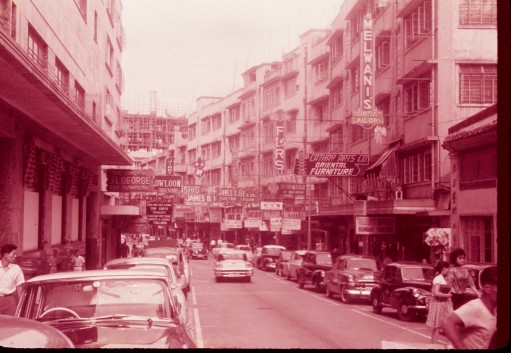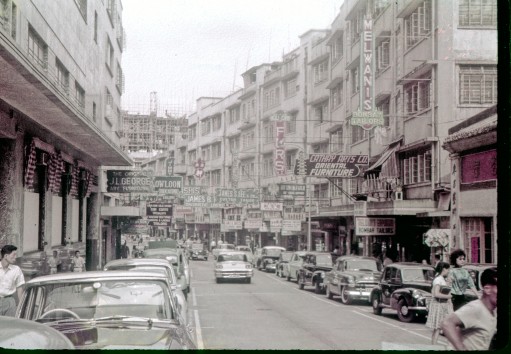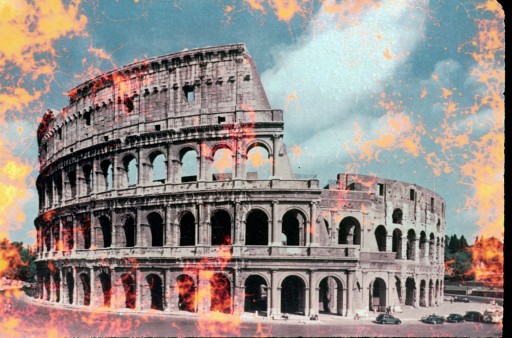The demise of Kodachrome last week did not surprise me – in fact, I thought Kodak had long ago ceased production. I have to say I regret it. I’ve recently been working on digitizing my grandfather’s collection of slides, taken on numerous exotic trips around the world, and the difference between the Kodachrome process slides and the others is astonishing.
Here is a scan of a 48 year old Kodachrome slide, a street scene in Burma. Other than dust removal, I have done no additional processing to the image:

A Burmese Street Scene
The colors are vivid and clear, the photo could have been taken yesterday. In contrast, here is an Ektrachrome slide, taken 2 weeks later on the same trip:

A Hong Kong street scene
Note how all the blue information has disappeared, and the picture has taken on a strong reddish tint. At the time, this was a full color image! Apparently it took Kodak years to realize that Ektachrome slides would lose most of their color, even when stored in dark. By that time, it was too late for many photographers.
Even extensive post-processing can only do so much. At least it is possible to reduce the overwhelming red hue, and recover a little bit of the remaining green and red pigments:

My grandfather purchased many commercial slides to fill out the records of the trip. Some of these commercial slides have fared even worse:

The Colosseum, Rome
At least they’ve decayed in interesting ways! I intend to do something interesting with the hundreds of extremely decrepit slides that look like this.
I could not help thinking that I am probably the last person who will ever physically handle these slides. Chances are that scanning technology won’t really improve sufficiently to justify ever scanning these slides again, and the Ektachrome slides will eventually fade away entirely.
A lot of today’s media face the same fate: DVD-R’s are this generation’s Ektachrome, with a viable lifetime much, much shorter than originally thought (5 to 10 years). The only way to keep digital media current seems to be continued copies onto newer and newer media, but even hard drives are not a good archival medium (lubricants in the bearings of a hard drive will eventually freeze up if the drive is not powered up for more than a year).
Keeping media alive is major effort, and one that is time-critical. Once the physical media has degraded, the effort quickly becomes so great that it will mostly never be made. Unfortunately, digital media seems to lack the equivalent of a Kodachrome, a stable medium that will last into future generations.
Bringing life to old media, and the death of Kodachrome
The demise of Kodachrome last week did not surprise me – in fact, I thought Kodak had long ago ceased production. I have to say I regret it. I’ve recently been working on digitizing my grandfather’s collection of slides, taken on numerous exotic trips around the world, and the difference between the Kodachrome process slides and the others is astonishing.
Here is a scan of a 48 year old Kodachrome slide, a street scene in Burma. Other than dust removal, I have done no additional processing to the image:
A Burmese Street Scene
The colors are vivid and clear, the photo could have been taken yesterday. In contrast, here is an Ektrachrome slide, taken 2 weeks later on the same trip:
A Hong Kong street scene
Note how all the blue information has disappeared, and the picture has taken on a strong reddish tint. At the time, this was a full color image! Apparently it took Kodak years to realize that Ektachrome slides would lose most of their color, even when stored in dark. By that time, it was too late for many photographers.
Even extensive post-processing can only do so much. At least it is possible to reduce the overwhelming red hue, and recover a little bit of the remaining green and red pigments:
My grandfather purchased many commercial slides to fill out the records of the trip. Some of these commercial slides have fared even worse:
The Colosseum, Rome
At least they’ve decayed in interesting ways! I intend to do something interesting with the hundreds of extremely decrepit slides that look like this.
I could not help thinking that I am probably the last person who will ever physically handle these slides. Chances are that scanning technology won’t really improve sufficiently to justify ever scanning these slides again, and the Ektachrome slides will eventually fade away entirely.
A lot of today’s media face the same fate: DVD-R’s are this generation’s Ektachrome, with a viable lifetime much, much shorter than originally thought (5 to 10 years). The only way to keep digital media current seems to be continued copies onto newer and newer media, but even hard drives are not a good archival medium (lubricants in the bearings of a hard drive will eventually freeze up if the drive is not powered up for more than a year).
Keeping media alive is major effort, and one that is time-critical. Once the physical media has degraded, the effort quickly becomes so great that it will mostly never be made. Unfortunately, digital media seems to lack the equivalent of a Kodachrome, a stable medium that will last into future generations.